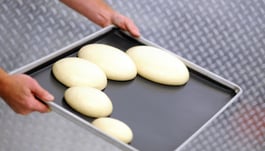 Veggie pizzas have grown in popularity as more and more consumers jump on the healthy-eating bandwagon, but making these pies palatable can be a real challenge for pizza operations. That’s because the significant water content in all those veggies — everything from artichokes to zucchini — works against efforts to bring a crispy, crunchy, pizza to the table.
Veggie pizzas have grown in popularity as more and more consumers jump on the healthy-eating bandwagon, but making these pies palatable can be a real challenge for pizza operations. That’s because the significant water content in all those veggies — everything from artichokes to zucchini — works against efforts to bring a crispy, crunchy, pizza to the table.
But there are pizza crust styles that stand up to watery toppings, and simple baking tips and methods that help ensure a perfect, golden brown crust every time.
Here, we’ll explain six tips to prevent soggy pizza crusts from turning a memorable experience into a mushy mess:
- Use a higher heat
- Allow fresh mozzarella to dry
- Practice portion control
- Prep your veggies
- Use par-baked pizza crusts
- Consider pre-made pizza dough balls
1. Use a Higher Heat
It’s important for any heavily veggie-topped pizza to be cooked at a slightly higher temperature. This helps “seal” the crust before it has a chance to absorb too much moisture.
Not all crusts can take the heat often associated with brick ovens or pizza stones, however. Alive & Kickin’s Classic Neapolitan Dough Balls, for example, are made from imported Italian flour and work great with high-heat oven applications of 600° F and up. Be sure to experiment to find the right temperature, as all ovens vary.
2. Allow Fresh Mozzarella to Dry
If you’re using fresh mozzarella (which has a 52% water content) on your veggie pizzas to give them added flavor and enhance the visual appeal, allow the cheese to dry a bit before adding it to the crust.
Instead of slicing the mozzarella and immediately placing the cheese on the crust, set the slices on a paper towel to absorb excess moisture for at least 15 minutes, flipping once to make sure both sides “drain.” You could also place it in a colander and allow liquid to drain prior to blotting it with towels. Regular mozzarella has very little water content, comparatively, and doesn’t require this step.
3. Practice Portion Control
It’s tempting to mound on the toppings, but when it comes to veggie pizza recipes, less is best. Measuring your ingredients every time, including toppings and pizza sauce, will help determine just the right quantities that give you the results you want. If you make your own pizza dough from scratch, it can vary widely from one batch to the next depending on humidity, ingredients and more. Using a par-baked pizza crust or pre-made dough ball ensures consistent performance, quality and cost every time.
TIP: Use our Pizza Toppings Portions Chart on page 4 of this guide!
4. Prep Your Veggies
Common vegetables used on veggie pizzas like bell peppers, broccoli, onions, mushrooms, black olives and spinach are often considered the most flavorful combinations, but they’re also ranked among those with the highest moisture content. Consider grilling, roasting or sautéing vegetables before putting them on the crust; this not only adds another element of flavor to the toppings, but releases much of the moisture.
Be sure to use a slotted spoon when removing them from the pan and place them on a paper towel at room temperature. Rather than using only fresh cherry tomatoes which have a very high moisture content, try combining sun-dried tomatoes in the mix to add a more intense and unique flavor profile.
5. Use Par-baked Pizza Crusts
Of all the different pizza crusts you can use, a par-baked crust is your best crust for veggie pizzas. Par-baked (meaning pre-baked, but not fully baked) crusts cut some of the baking time, so the watery toppings aren’t sitting on top as long and have less chance of soaking into the crust. Alive & Kickin’s Par-Baked Hand-Tossed Style Pizza Crusts have the look and feel of a traditional hand-tossed dough and a taste that scratch-made and even homemade pizza can’t beat.
Regardless of which crust you use, allow your baked pizza to rest at room temperature for about a minute on a cooling rack rather than placing it directly into a delivery or take-out box. This allows some of the steam to evaporate rather than soaking into the crust.
6. Consider Pizza Dough Balls
If par-baked crusts aren’t your thing, there are many premade dough balls from Alive & Kickin’ that’ll do the trick with veggie topped pizzas. Premade dough balls offer an advantage of moisture consistency, giving you dough that is always perfect to use for veggie pizzas.
Don’t let the moisture in vegetables keep you from offering this popular option at your pizza operation – use the right dough or crust product instead! Selecting the right product for your needs and following steps designed to minimize moisture will make this menu option a real winner with your veggie-loving customers!
Learn more about how toppings impact crust along with suggested portions in our guide below.





